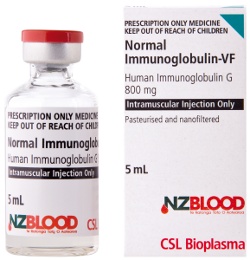|
Presentation
|
- Normal Immunoglobulin-VF - 800mg in 5mL
- Normal Immunoglobulin is a solution of human immunoglobulin
(antibodies) prepared from pooled plasma donations made from New
Zealand donors for intramuscular use.
- NZBS also provides
|

|
|
ABO Compatibility
|
- Compatibility is not relevant for manufactured (fractionated)
plasma product transfusion
|
|
Storage and Infusion
|
- Inject promptly. Do not give intravenously. If any delay store at 2-8°C in
an appropriately monitored refrigerator.
|
|
Precautions
|
- Read manufacturer's instructions carefully
- Always observe for turbidity, floating material
and sediment
- Intra-muscular products - follow recommended best practice.
- Specific information about the administration of each product
is given in the manufacturer's product information
|
|
Alternatives
|
|
|
Vaccination
|
- Inactivated vaccines:
- Inactivated vaccines may be administered concurrently with passive
antibody (although in separate syringes injected into separate limbs) to induce active immunity.
- Live attenuated virus vaccines:
- Passively acquired antibody can interfere with the response to live,
attenuated virus vaccines. Therefore, administration of such vaccines, e.g. poliomyelitis or measles,
should be deferred until approximately three months after passive immunisation.
- If Normal Immunoglobulin-VF is administered within two weeks of vaccination with a live attenuated virus vaccine,
the efficacy of the vaccine may be compromised. Consideration should be given to re-vaccination
approximately three months after the immunoglobulin was given.
- Passive Transfer of Antibodies and Interference with Serological Testing:
- After injection of Normal Immunoglobulin-VF, the transitory rise of the various passively transferred antibodies in
the patient's blood may result in misleading positive results in serological testing.
|
Monitoring |
- Recipients should remain under observation for 20 minutes following administration in case they experience an immediate adverse event requiring treatment.
|
|
DO NOT
|
- DO NOT add medications to blood products.
|
|
Doses
|
- Hepatitis A: see datasheet
- Measles prophylaxis: current guidance (not in datasheet) recommends 0.6 mL/kg bodyweight to a maximum of 15 mL
- Poliomyelitis: 0.3 mL/kg bodyweight
- Hypogammaglobulinaemia: 0.6 mL/kg monthly
- Rubella: discuss with infectious diseases specialist
|
|
More Info
|
|
|
